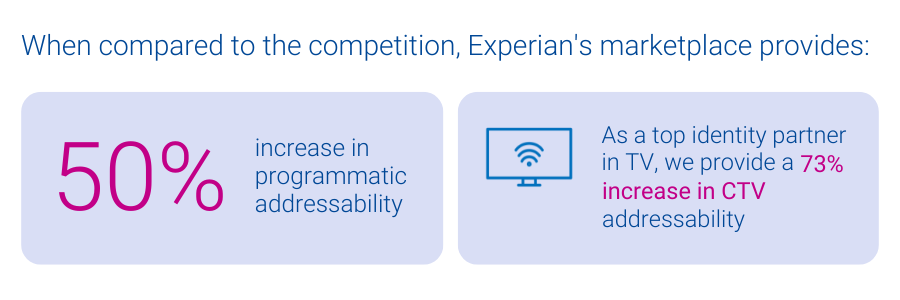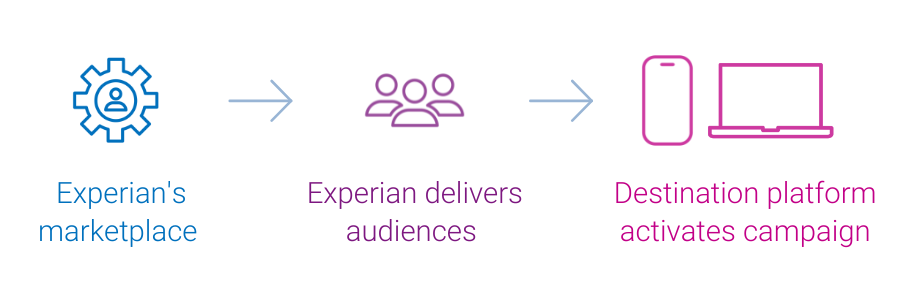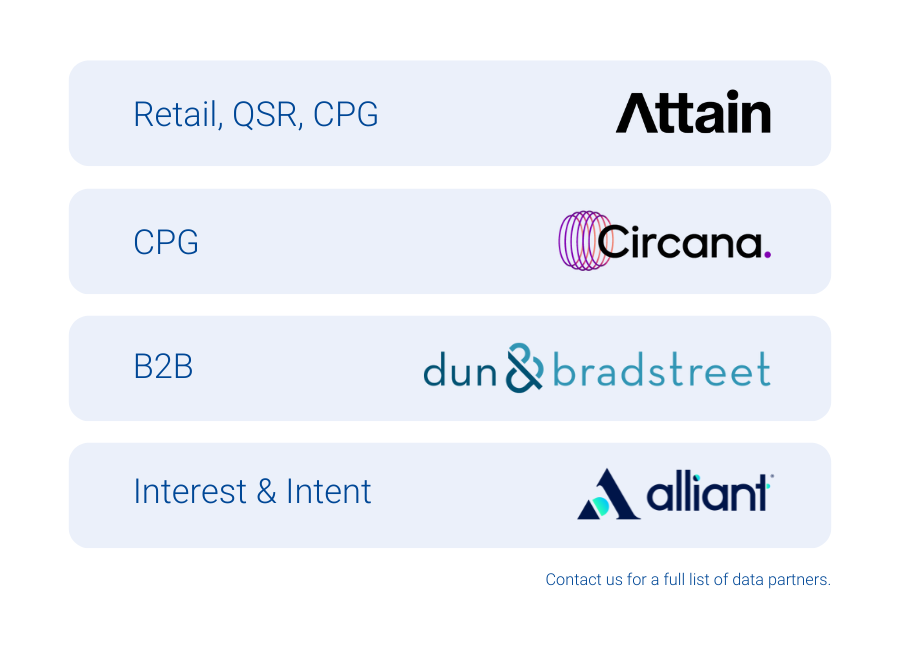
In a perfect world, we’d all have a single, go-to grocery store that carried everything on our shopping list – fresh produce, gourmet coffee beans, rare spices, and maybe even that special-grade olive oil, right alongside our wholesale bulk purchases at unbeatable prices. It would be convenient and efficient, and it’d save a lot of driving around town.
The changing data marketplace: From one-stop shop to specialized selection
For a long time, data buyers enjoyed something similar in their world: a small set of large-scale data marketplaces that offered a wide array of audiences, making it easy to load up on whatever you needed in one place. Not only are there fewer places to pick everything up, but new factors like privacy and signal deprecation are placing a spotlight on quality and addressability.
Just as our dinner plans are growing more ambitious insofar as we want health, flavor, value, and convenience all in one place – so are our data strategies. Instead of a single steak-and-potatoes meal, today’s data marketplace operators might be cooking up a complex menu of campaigns.
“Experian has been a longstanding partner of DISH Media, and we’re excited to be an early adopter of their marketplace which leverages the foundation of their identity solutions to ensure maximum cross-channel reach as we look to expand the breadth and depth of data we use for addressable TV.”
Kemal Bokhari, Head of Data, Measurement & Analytics, DISH Media
As a result, data buyers are beginning to shop around. Some still rely on large-scale marketplaces for familiar staples, but now they have reasons to explore other options. Some are turning to providers known for offering top-tier, transparently sourced segments. Others are focusing on specialty providers that excel in one area.
A more selective approach to data buying
In this environment, choosing where to “shop” for data is becoming more deliberate and selective. Data buyers aren’t just thinking about broad scale; they’re looking to prioritize quality, durability, data privacy, and differentiation. They need to place higher value on data marketplaces that can maintain audience addressability over time, despite signal loss. Sometimes, that means accepting a smaller assortment in exchange for tighter vetting and more reliable targeting. Other times it means mixing and matching – stopping by one marketplace for premium segments and another for cost-friendly, wide-reaching data sets. Either way, they can benefit from having more choices.
“Experian has been a longstanding partner of DISH Media, and we’re excited to be an early adopter of their marketplace which leverages the foundation of their identity solutions to ensure maximum cross-channel reach as we look to expand the breadth and depth of data we use for addressable TV.”
Kemal Bokhari, Head of Data, Measurement & Analytics, DISH Media
Experian’s marketplace: A trusted source for high-quality data
Experian’s vetted and curated blend of data partners and vertically-aligned audiences offers a trusted specialty store for data buyers. Experian’s marketplace, powered by identity graphs that include 126 million households, 250 million individuals, and 4 billion active digital IDs, enables partner audiences to be easily activated and maintain high addressability across display, mobile, and connected TV (CTV) channels. In particular, Experian’s marketplace provides:


The future of data marketplaces: Precision and flexibility matter
The evolution of data marketplaces reflects the industry’s shifting priorities. Data buyers seek specificity, reliability, and adaptability to align with their diverse campaign needs. The best data strategy, much like the best grocery run, isn’t about grabbing everything in one place – it’s about carefully selecting the right ingredients to create the perfect recipe for success. This shift underscores the importance of flexibility and precision as data buyers navigate a landscape shaped by privacy regulations, signal loss, and evolving consumer expectations.

As data marketplaces adapt to meet these demands, they are redefining what it means to deliver value. Experian’s marketplace enables buyers to strike the perfect balance between reach and quality by offering enhanced match rates, precise audience planning, and seamless distribution. In this new era, data buyers have the tools and options to craft campaigns that are impactful and aligned with the increasingly selective and privacy-conscious digital landscape. The key is recognizing that today’s data strategy is about utilizing the strengths of many to create a cohesive and effective whole.
If you’re interested in learning more about Experian’s marketplace or becoming an active buyer or seller in our marketplace, please contact us.
Latest posts

If the time spent on the Internet for personal computers was distilled into an hour then 27 percent of it would be spent on social networking and forums across the United States, United Kingdom and Australia. In the U.S., 16 minutes out of every hour online is spent on social networking and forums, nine minutes on entertainment sites and five minutes shopping. Global comparison In the UK, 13 minutes out of every hour online is spent on social networking and forums, nine minutes on entertainment sites and six minutes shopping. Australian Internet users spend 14 minutes on social sites, nine on entertainment and four minutes shopping online. Across all three markets, time spent shopping online grew year-over-year, but the UK market emerged as having the most prolific online shoppers, spending proportionally more time on retail Websites than online users in the U.S. or Australia. British Internet users spent 10 percent of all time online shopping in 2012, compared to nine percent in the U.S. and six percent in Australia. This was in part due to a bumper winter holiday season in the UK where 370 million hours were spent shopping online, 24 percent higher than the monthly average. Consumption of news content also increased across all three markets with Australian users emerging as the most voracious consumers of news online. Six percent of all time spent online in Australia in 2012 was on a news Website, compared to five percent in the UK and four percent in the U.S. Meanwhile, the time spent on social media proportionate to other online activities declined across all three regions. The U.S., which has been the most dominant market for social media consumption in the last three years dropped from 30 percent of all time spent online to 27 percent. In Australia time spent on social dropped from 27 percent to 24 percent while in the UK it dipped from 25 percent to 22 percent year-over-year. This highlights the rise in access via 3G and 4G networks as consumers spend increasingly more time online while on the move. "Understanding consumer behavior across channels is more important than ever as more visits are being made on the move, particularly among social networking and email,” says Bill Tancer, general manager of global research for Experian Marketing Services. "With smartphones and tablets becoming more powerful, our data clearly indicates the difference between mobile and traditional desktop usage further enabling the ‘always on’ consumer mentality. Marketers need to understand these differences, as well as regionally, to ensure campaigns can be tailored for better and more effective engagement.” Mobile browsing When looking at the U.S. browsing data for mobile devices, email accounted for the largest time spent on average, for the same categories for Q1 2013. Email made up 23 percent of time spent on mobile devices for Q1-13, while social networking accounted for 15 percent. Entertainment had the third highest time spent with 13 percent, followed by shopping with 11 percent and travel with 9 percent. The mobile data does not include app usage, but does include mobile browsing within an app. Read more of the latest consumer trends in The 2013 Digital Marketer Report Learn more about consumer online behavior by visiting our Online Trends page Learn more about the author, Matt Tatham

The 2013 Digital Marketer Report is almost here. One section of the report includes key segments of the consumer landscape. In a previous post we looked at budget and luxury travelers and in this excerpt we focus on millennials – specifically tactics to target early adopter millennials: The generation of 18- to 34-year-olds known as millennials is an increasingly influential group that impacts many aspects of the American lifestyle, including fashion, technology, entertainment and beyond. Almost one-quarter (24 percent) of millennials have a college degree, 34 percent are married and many (60 percent) own a home. They have an average discretionary spend of $11,317 annually. Brands and marketers are taking notice of millennials and the fact that they communicate and behave differently than other generations. Marketers increasingly understand that they need innovative marketing programs in order to engage this important segment of the population Early adopter millennials Fifty-two percent of millennials rank far above or above average when it comes to being early adopters of technology. That means more than half of adults ages 18 to 34 want to be the first to have the latest electronic equipment, are willing to pay almost anything for an electronic product and actively want to be a source of information on electronic equipment to others Marketers trying to reach this group can look at the types of Websites driving millennials to online retailers in order to understand other sites that would be effective partners, advertising outlets and content providers: Millennials are more likely than the online population to visit search and social Websites before visiting a retail Website They are less likely to look at email or visit reward and directory sites before visiting a retail Website They are more likely to visit fashion content and portal sites before visiting a retail Website There is a major opportunity to reach early adopter millennials via mobile, as they spend 14 percent more time engaged with their mobile devices in an average week than their generational peers. Early adopter millennials are 20 percent more likely to use a tablet and 32 percent more likely to IM/chat than the average millennial. Other top activities include reading media, listening to music and email. Source: Experian Marketing Services’ Simmons® Source: Experian Marketing Services’ Simmons Source: Experian Marketing Services’ Simmons For more insights on millennials and other key consumer segments, pre-order The 2013 Digital Marketer Report.

The 2013 Digital Marketer Report is almost here. In anticipation of its release, here’s an excerpt from the online display advertising section: Here’s what marketers and advertisers need in order to lay the groundwork for success in their online advertising campaigns: Solid audience-based data is the foundation for display advertising success. Start with your CRM file and work with the right partners who can best leverage it and enhance your audience definition with robust data assets to create a highly targeted display audience. Actionable, value-based segmentation is a key campaign driver. Value-based segmentation assigns predicted economic values to customer or prospect audience targets – based upon the campaign objective – for the more cost-efficient real time display ad buying. Applying value-based segmentation to an audience according to sound consumer insights and analytics allows for more dynamic and cost-effective display media bidding. Scalability to drive campaign efficiency. You’ve defined your target audience with value-based segments. Now you need to reach that specific audience at scale to maximize campaign efficiency and get the most from your media budget. High-quality creative to drive engagement and conversion. Developing the right audience, targeting parameters and media strategy is only as good as the creative message displayed so the importance of highly relevant, targeted creative cannot be underestimated. Work with a partner who understands your target audience and campaign objectives to develop and deliver the most compelling message. Approaching your online display campaign set up this way will ensure it is built on a solid foundation, greatly increasing the likelihood of your program’s success. Keep in mind that data-driven, audience-based campaigns typically take a little more ramp-up time than more traditional advertising. Sometimes, if companies don’t see results right away, they might change or abandon their strategy too quickly. This new, digital path truly requires a shift in advertiser behavior and thinking. All is not lost if you don’t see results right out of the gate. The systems need time to use the data to target the best audience, hone in on the right media for that audience and bid on it accurately. All of these steps take time but are needed to drive performance. Marketers in the trenches may get comfortable as they start to see results, but they sometimes struggle with getting their senior leadership to accept the longer time frame and keep spending on display programs. Brand advertisers tend to buy into display better than performance-based advertisers because they are used to the time required to create repeated exposure that builds awareness, consideration, favorability and intent. The key takeaway is that you need to go into these campaigns feeling comfortable about the longer timeline required to allow traction and drive the results you seek. Pre-order The 2013 Digital Marketer Report today and be one of the first to get more great data, trends and insights.